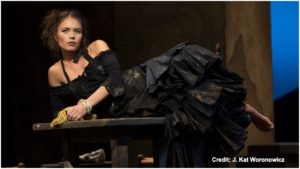
San Diego Opera 2018-19 Review: Carmen
Ginger Costa-Jackson Enchants Audience With Mature Interpretation of Iconic Character
By Maria NockinOn March 31, 2019, San Diego Opera presented Georges Bizet’s opera “Carmen” to a mostly sold out audience at the Civic Theatre. Kyle Lang was both stage director and choreographer of this thoughtful and elegant production that began with two male dancers, Laurence Gonzalez and Lester Gonzalez, as a soldier and a bullfighter dancing for supremacy during the the overture.
In 1875, the composer described his last opera as a work full of color and melody. That was the show Lang and Conductor Yves Abel gave San Diegans.
Color & Melody
Scenic Designer R. Keith Brumley provided a tall facade for the soldiers in the first act and a rustic cafe with tables under a huge candle-lit chandelier for Act two. In Act three we were greeted by an ancient ruin and for the final act we saw the entrance to the bull ring. That scene blazed with Designer Chris Rynne’s red lighting at the tragic finale.
James Schuette’s costumes dressed the cigarette factory workers and most of the townspeople in neutrals. Meanwhile Carmen’s attire saw colorful evolution over the course of the night. For the first act, Carmen wore black, but by the time the bullfight rolled around she wore red. Micaela wore the “Jupe bleue” mentioned in the libretto, while the soldiers sported large pale blue hats and matching coats with gold braid over cream colored pants.
Growing Into The Icon
A few years ago, I saw Ginger Costa-Jackson portray Carmen at San Francisco Opera in a novel production by Calixto Bieito. Hers was a fine interpretation then, but both her distinctive voice and her sensitive interpretation have grown immensely since that time.
This artist’s Carmen knows her worth and she will defy the cultural norms of her time for the right to live her life her own way. Women love this character if they agree with her and hate her if they don’t. Men just know she exudes sexuality.
Most singers have found the “Habanera” the most difficult aria of the title role, but Costa-Jackson sang it with pizzazz as she used the entire stage, over which the chorus was spread out, to demonstrate the vagaries of the rebellious love bird.
Costa-Jackson can dance, so the “Gypsy Song” was great fun as she and her companions whirled from floor to table and back again. When Carmen danced for Don José, she proved to be a virtuoso on the castanets. Although not every Carmen is comfortable with the low tessitura of the “Card Song,” Costa-Jackson seemed to revel in it. Her downward tones were exquisite and they became multicolored jewels as they spun out over the audience.
The Tragic Characters
Robert Watson was a gullible Don José with a large voice that he manages well. His “Flower Song” had a beautiful legato and its pianissimo ending came off perfectly. In Act one, he was something of a country bumpkin, but later he became wise to the ways of the Gypsies. Then he was cynical about love in general and Carmen in particular. As his character grew, his descent into murder became logical.
Although Sarah Tucker sang with sweet tones and made as much of her role as possible, Micaëla is a difficult character to create. She seems docile, but inside she has strength enough to risk a dangerous trip alone through the mountains to get her man away from a woman who is toying with his emotions. Unfortunately, she does not have enough time on stage to fully flesh out her personality. We will never know if she would have responded to Moralès if he had been less forward with his hands.
Rounding It All Out
As Frasquita and Mercedes, Tasha Koontz and Guadalupe Paz rounded out Carmen’s social and musical group. Koontz provided secure silvery high notes, while Paz added the warmth of dulcet lows. Bass-baritone Patrick Blackwell was an outstanding Zuniga who sang with dark tones and let everyone know he was the guard’s officer. I hope we will hear more of him in San Diego.
As Escamillo, baritone Scott Conner charmed the gypsies at Pastia’s and was the focal point of the pre-bullfight festivities as he sang with command in his voice. Brian Vu was an interesting Moralès, while Bernardo Bermudez and Felipe Prado were assets to the Gypsy community as they provided physical and harmonic strength.
Not As Reliable
I wish the orchestra had been as reliable as the singers. Unfortunately, the members of the San Diego Symphony did not seem as familiar with the “Carmen” score as one might anticipate from an experienced ensemble. Conductor Yves Abel opened at a fast pace and although the musicians caught up when he slowed down, the instrumental playing was not always clean. Abel did keep the show moving briskly and he was careful never to drown out a singer.
Five years ago the San Diego Opera audience heard that their opera was dying. It never happened thanks to the largesse of many people and in 2019 the company seems on firm and substantial ground. This “Carmen” emphasizes this very fact and it is truly encouraging to see such star talent as Costa-Jackson lead its major productions.


